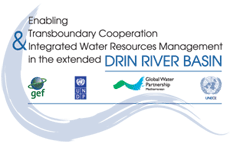Nature Based Solutions for Wastewater Management
Deterioration of water quality was one of the four transboundary issues that were identified by the Transboundary Diagnostic Analysis (TDA), which found that a considerable amount – 40%– of total nutrient (TN and TP) emissions in the Drin Basin originates from the White Drin Basin.
With the exception of the Lake Ohrid sub-basin, wastewater management is unsatisfactory in the Drin Basin by EU Urban Wastewater Treatment (UWWT) Directive standards. In the White Drin sub-basin in particular, all household wastewater is discharged untreated.
The Drin Core Group requested to test a replicable, low-cost and high-efficiency solution suitable for small settlements below 2000 inhabitants, to address localized pollution related pressures and minimize subsequent effects to the biodiversity and human health in rural areas of the Drin Basin.
The use of Constructed Wetlands was tested being a nature based solution that presented a number of advantages. It has low construction, operation and maintenance costs, it is efficient and is easy to operate. As such, it is likely that other rural settlements in the area might be interested in applying it.
The village of Kramovik in Kosovo1 was chosen, directly benefiting 1100 residents. According to the specifications provided by the constructor, this solution was expected to reduce pollution by 90%. It was built on municipal land, while the capital investment was a contribution by the GEF Drin Project. UNDP and GWP-Med coordinated the implementation of the activity -including the construction- while national and local institutions provided their input and support. Stakeholders were consulted and updated on the construction’s technical details throughout the process, in order to ensure a high level of ownership by those who would be directly affected by this project.
The infrastructure consisted of:
- A screening chamber where pre-treatment of wastewater takes place.
- A septic tank called Anaerobic Baffled Reactor (ABR) whereby nutrients and BOD5 are reduced up to 90%.
ABR working principle (according to Compendium of Sanitation System, 2008
- A drying bed, where sludge is turned into organic matter (that could be used as fertilizer).
Principle of Drying Bed (according to Compendium of Sanitation System, 2008)
- A horizontal constructed wetland. This consisted of:
- a 60 x 20m “filter” filled up with sand and gravel layers that is planted with reeds of Phragmites australis (Cav.) Trin Ex Steudel / communis; after the ABR, wastewater flows into this filter, and is used as “food” for the reed in the constructed wetland.
- pipelines that distribute the wastewater throughout the wetland.
- waterproof geomembranes preventing wastewater infiltrating and percolating into the soil.
By the time water enters into the White Drin, it carries less pollution load, significantly contributing to the improvement of water quality locally but also throughout the basin.
Action was being taken for this solution to be replicated in other parts of the Drin Basin as it is a cost-efficient solution for small rural settlements below 2000 inhabitants that sit far from centralized wastewater treatment plants.
[1] This designation is without prejudice to positions on status, and is in line with UNSCR 1244/1999 and the ICJ Opinion on the Kosovo declaration of independence.







